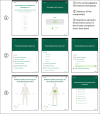Obtaining patients' medical history using a digital device prior to consultation in primary care: study protocol for a usability and validity study
- PMID: 35854290
- PMCID: PMC9297616
- DOI: 10.1186/s12911-022-01928-0
Obtaining patients' medical history using a digital device prior to consultation in primary care: study protocol for a usability and validity study
Abstract
Background: With the help of digital tools patients' medical histories can be collected quickly and transferred into their electronic medical records. This information can facilitate treatment planning, reduce documentation work, and improve care. However, it is still unclear whether the information collected from patients in this way is reliable. In this study, we assess the accuracy of the information collected by patients using an app for medical history taking by comparing it with the information collected in a face-to-face medical interview. We also study the app's usability from the patients' point of view and analysing usage data.
Methods: We developed a software application (app) for symptom-oriented medical history taking specialized for general practice. Medical history taking will take place involving patients with acute somatic or psychological complaints (1) using the app and (2) verbally with trained study staff. To assess the perceived usability, patients will complete a questionnaire for the System Usability Scale. We will collect sociodemographic data, information about media use and health literacy, and app usage data.
Discussion: Digital tools offer the opportunity to improve patient care. However, it is not self-evident that the medical history taken by digital tools corresponds to the medical history that would be taken in an interview. If simply due to a design flaw patients answer questions about signs and symptoms that indicate possible serious underlying conditions 'wrong', this could have severe consequences. By additionally assessing the app's usability as perceived by a diverse group of patients, potential weaknesses in content, design and navigation can be identified and subsequently improved. This is essential in order to ensure that the app meets the need of different groups of patients. Trial registration German Clinical Trials Register DRKS00026659 , registered Nov 03 2021. World Health Organization Trial Registration Data Set, https://trialsearch.who.int/Trial2.aspx? TrialID = DRKS00026659.
Keywords: App; Digital medical history taking; Primary care; User friendliness.
© 2022. The Author(s).
Conflict of interest statement
The authors declare that they have no competing interests.
Figures



References
-
- Roshan M, Rao AP. A study on relative contributions of the history, physical examination and investigations in making medical diagnosis. J Assoc Physicians India. 2000;48:771–775. - PubMed
-
- Brandberg H, Kahan T, Spaak J, Sundberg K, Koch S, Adeli A, et al. A prospective cohort study of self-reported computerised medical history taking for acute chest pain: protocol of the CLEOS-chest pain danderyd study (CLEOS-CPDS) BMJ Open. 2020;10:e031871. doi: 10.1136/bmjopen-2019-031871. - DOI - PMC - PubMed
Publication types
MeSH terms
Associated data
LinkOut - more resources
Full Text Sources

